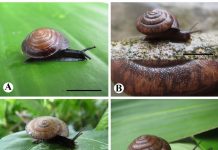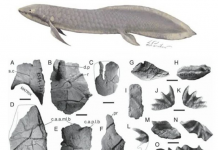Assistant Professor Dr Piyatida Pimvichai, a researcher from the Department of Biology, the Faculty of Science, Mahasarakham University, and colleagues published an article in the European Journal of Taxonomy in 2016. The publication is entitled “A revision of the Thyropygus allevatus group. Part V: Nine new species of the extended opinatus subgroup, based on morphological and DNA sequence data (Diplopoda: Spirostreptida: Harpagophoridae).”
Abstract: The Thyropygus opinatus subgroup (Diplopoda: Harpagophoridae) of the T. allevatus group in Thailand is revised. Based on a phylogenetic analysis of mtDNA sequence data, it is merged with the T. bifurcus subgroup to form an extended T.opinatus subgroup. Nine new species are described: Thyropygus cimi sp. nov. and T. forceps sp. nov. from Nakhonsrithammarat Province, T. culter sp. nov., T. planispina sp. nov., T. undulatus sp. nov. and T. ursus sp. nov. from Krabi Province, T. mesocristatus sp. nov. from Songkhla Province, T. navychula sp. nov. from Phang-Nga Province and T. sutchariti sp. nov. from Phetchaburi Province.
Thyropygus cimi Pimvichai, Enghoff, Panha & Backeljau, 2016 (กิ้งกือหางแหลมแห่งวงการกิ้งกือ)
Etymology: This species is named after the organization “Centre International de Myriapodologie – CIM” (www.myriapodology.org) in recognition of its immense importance for inspiring and supporting research on myriapods.
Thyropygus culter Pimvichai, Enghoff, Panha & Backeljau, 2016 (กิ้งกือหางแหลมใบมีด)
Etymology: The name is a Latin noun in apposition, meaning “knife”, and refers to the knifelike second femoral spine (fe 2).
Thyropygus forceps Pimvichai, Enghoff, Panha & Backeljau, 2016 (กิ้งกือหางแหลมเท้าส้มหลังลาย)
Etymology: The name is a Latin noun in apposition, referring to the forceps-like gonopod coxae.

Thyropygus mesocristatus Pimvichai, Enghoff, Panha & Backeljau, 2016 (กิ้งกือหางแหลมสันตามยาว)
Etymology: The name is a Latin adjective, referring to the longitudinal crest on the mesal process of the anterior coxal fold.

Thyropygus navychula Pimvichai, Enghoff, Panha & Backeljau, 2016 (กิ้งกือหางแหลมทหารเรือและจุฬา)
Etymology: The species is named after the Royal Thai Navy, in recognition of their kind assistance which enabled us to pursue the necessary fieldwork at the type locality, and also after Chulalongkorn University where pink is the symbolic colour of the university, indirectly referring to the pink legs of the species; the species name is treated as a noun in apposition.
Thyropygus planispina Pimvichai, Enghoff, Panha & Backeljau, 2016 (กิ้งกือหางแหลมวัดถ้ำเสือ)
Etymology: The name is a Latin noun in apposition and refers to the flattened tibial spine (ti).
Thyropygus sutchariti Pimvichai, Enghoff, Panha & Backeljau, 2016 (กิ้งกือหางแหลมสุจริต)
Etymology: The species is named in honour of Chirasak Sutcharit in recognition of his devotion to collecting millipedes.
Thyropygus undulatus Pimvichai, Enghoff, Panha & Backeljau, 2016 (กิ้งกือหางแหลมขอบหยัก)
Etymology: The name is a Latin adjective, referring to the undulate/coarsely dentate laterodistal margin of the lateral process of the anterior coxal fold.
Thyropygus ursus Pimvichai, Enghoff, Panha & Backeljau, 2016 (กิ้งกือหางแหลมเกาะลันตา)
Etymology: The name is a Latin noun in apposition, meaning “bear”, and refers to the (somewhat) bearhead-like profile of the lateral process of the anterior coxal fold (alp).


Pimvichai P., Enghoff H., Panha S. & Backeljau T. 2016. A revision of the Thyropygus allevatus group. Part V: Nine new species of the extended opinatus subgroup, based on morphological and DNA sequence data (Diplopoda: Spirostreptida: Harpagophoridae). European Journal of Taxonomy 199: 1–37. http://dx.doi.org/10.5852/ejt.2016.199.







